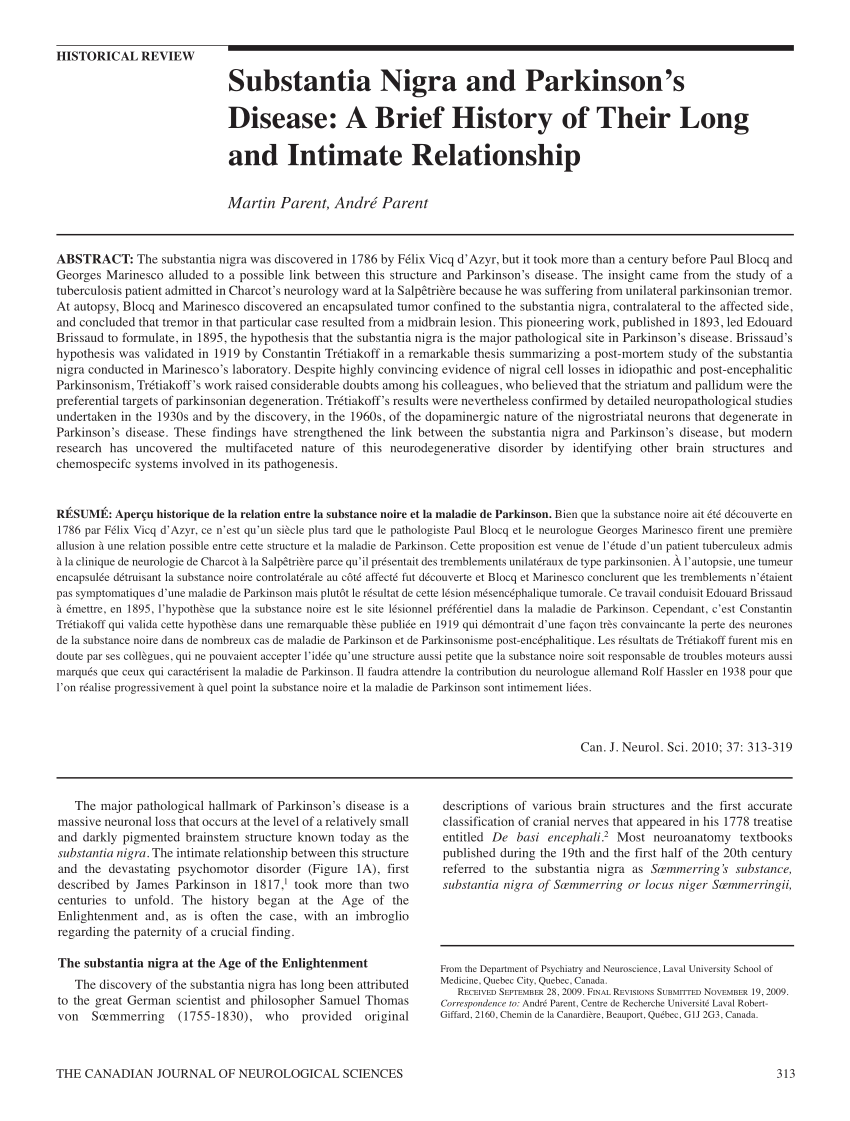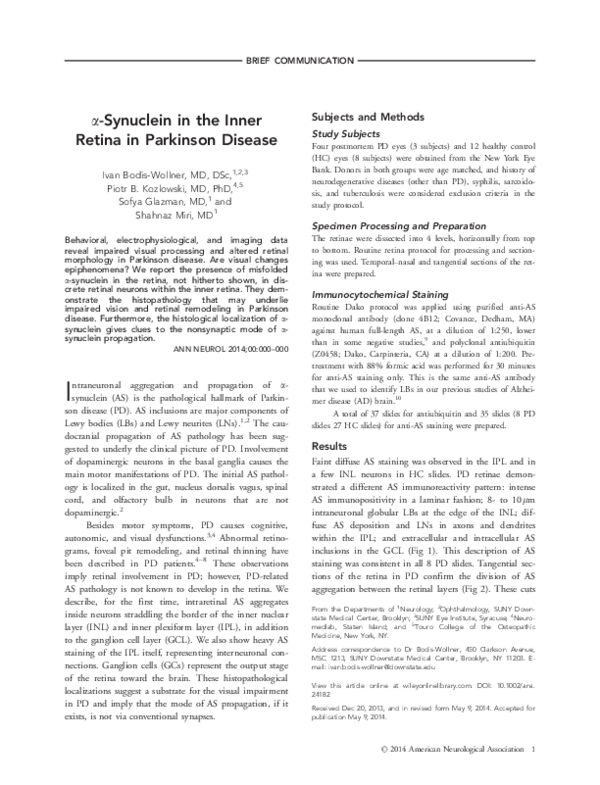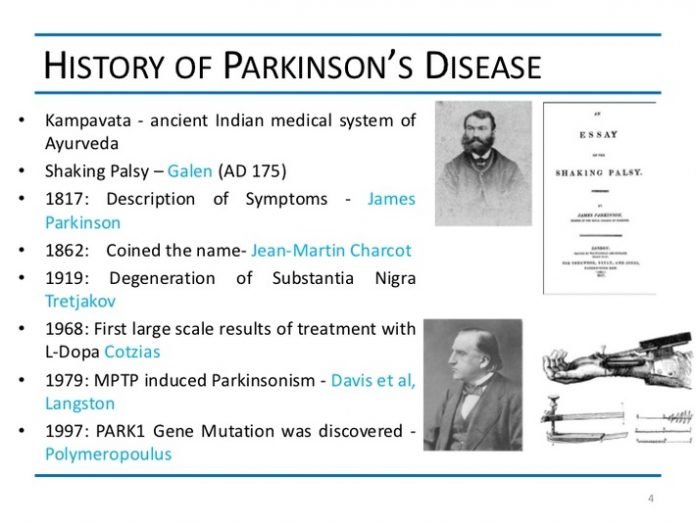A Little Bit Of History
A new important breakthrough took place in 1983 when Langston and colleagues reported a group of drug users who developed acute parkinsonism after MPTP exposure . These patients developed an acute syndrome indistinguishable from PD. This is due because the MPTP metabolite, MPP+, destroys the dopaminergic neurons in the substantia nigra after a series of alterations in the mitochondrial matrix and the electron transport chain. The SNc of Parkinson patients was also described as exhibiting a marked decrease in complex I activity . The fact that some PD patients have certain polymorphisms in genes that express subunits of complex I suggests that this could be a vulnerability factor in PD . New models based on MPTP intoxication allowed researchers to ascertain PD hallmarks both in vitro and in vivo . Due to the achievements of pharmacological DA treatments, search of cell-based DA replacement approaches were initiated with largely disappointing results . From the surgical and therapeutic point of view, discrete lesions of the BG improved parkinsonism . A monkey model of PD showed motor signs improvement as a result of the chemical destruction of the subthalamic nucleus , with evidence of reversal of experimental parkinsonism by STN lesions. This same year deep brain stimulation of the STN became effective for PD treatment .
Figure 1. Breakthroughs in Parkinsons disease history.
Diagnosis And Clinical Assessment Devices
The use of new technology-based tools allows quantitative assessment of the motor function of PD patients. Sensors, video-assessment methods or mobile phone applications are some of the techniques that improve the sensitivity, accuracy and reproducibility of the evaluation of PD patients . Portable devices that include inertial measurement units measure the orientation, amplitude and frequency of movement, as well as the speed of the part of the body where they are located. IMUs are usually made up of accelerometers and gyroscopes, and occasionally magnetometers. IMUs situated in different parts of the patients body make a precise record of tremor, bradykinesia, dyskinesias and even gait patterns . On the other hand, continual monitoring of the motor status in the domestic environment is also possible by using these technology-based tools . These new technology-based systems open up an unexpected range of specific and real-time data, thereby resulting in the prospect of better diagnostic accuracy, more sensitive monitoring of the motor and non-motor symptoms, and more precise adjustments of medical therapies. However, their use is limited in routine clinical practice due to the heterogeneity of the studies, which limit the extrapolation of results, and the high cost of the devices .
Advances In Parkinsons Disease: 200 Years Later
- 1HM CINAC, Hospital Universitario HM Puerta del Sur, Madrid, Spain
- 2Biomedical Research Networking Center on Neurodegenerative Diseases , Madrid, Spain
- 3Department of Neuroscience, Centro de Investigación Médica Aplicada , University of Navarra, Pamplona, Spain
- 4Pharmaceutical Technology and Chemistry, School of Pharmacy and Nutrition, University of Navarra, Pamplona, Spain
- 5Instituto de Investigación Sanitaria de Navarra , Pamplona, Spain
- 6Neurodegenerative Diseases Research Group, Vall dHebron Research Institute, Barcelona, Spain
- 7Laboratory of Parkinson Disease and other Neurodegenerative Movement Disorders, Department of Neurology, Hospital Clínic de Barcelona, Institut dInvestigacions Biomèdiques August Pi i Sunyer , University of Barcelona, Barcelona, Spain
- 8Department of Anatomy, Histology and Neuroscience, Facultad de Medicina, Universidad Autónoma de Madrid, Madrid, Spain
Also Check: Does Jack Kornfield Have Parkinson’s
A Brief History Of Parkinson’s Disease
Some people believe that Parkinson’s Disease is a new diagnosis, or a neurological disorder of the modern era. It also seems as if over the past 10 to 15 years that there’s been a surge in the prevalence of PD. There is some truth to both those statements. With the substantial percentage of the baby-boomer population entering their 6th decade, we are indeed observing a spike in all geriatric conditions, including PD. Currently in the United States, there are approximately 6.2 million individuals living with Parkinson’s Disease, and there are about 630,000 new cases diagnosed each year. With an estimated cost of $22,800 per person per year, to maintain the condition, the total economic burden of Parkinson’s is substantial, at approximated $14.4 billion annually. This amount is suspected to double by the year 2040.
However, Parkinsons disease is certainly not a modern day disease. As a matter of fact, Parkinsons disease had a much higher prevalence in the early 20th century following the influenza epidemic of 1916-1917.
About 2 centuries later, in the year 1817, Dr. James Parkinson wrote the essay on The Shaken Palsy, as Galen called it. The essay on the Shaking Palsy was essentially a letter, or an essay, about how he observed six cases of different people, who had similar characteristics:
A shaking of body parts that decreased with voluntary movement
A bending of the trunk forward, or a stooped posture
Preservation of intellect
A Brief History Of Cannabis Use For Parkinsons Disease

Parkinsons disease is the second most common neurodegenerative disorder in the United States, after Alzheimers disease. Its also the 14th most common cause of death in all age groups. Theres no cure yet for this progressive neurological disorder. Available medications for controlling its symptoms arent always effective and can have severe side effects.
But after nearly three decades of sometimes conflicting studies, recent research reveals that cannabis compoundsparticularly tetrahydrocannabinol can ease not only the well-known motor symptoms of Parkinsons disease, but also the less obvious ones of pain, depression and loss of senses such as taste, smell and touch. Whats more, .
FOLLOW US ON &
Don’t Miss: How Does General Anesthesia Affect Parkinson’s
The Search For Effective Treatments For Parkinsons Disease
Standard Parkinsons disease treatments arent always effective and can have serious side effects. Medications such as Levodopa and Tolcapone work to prevent the breakdown of dopamine in the brain and boost the effects of existing dopamine production, but these drugs can cause complications such as liver failure and an increase in dyskinesia.
Surgical intervention can also be used to reduce Parkinsons symptoms. Deep brain stimulation can moderate involuntary movement and coordination problems by implanting electrodes into the brain, but this approach brings the usual risks of surgery and may not always be effective.
The effort to find safer and more effective treatment options prompted the earliest research on cannabis to relieve the motor symptoms of Parkinsons disease, nearly three decades ago.
Levodopa As A Defense Against Its Neighbors
Levodopa is not abundant in nature. Why are some plants generating levodopa? To defend themselves and to attack other vegetables. Levodopa is a precursor to many alkaloids, catecholamines and melanin, and when the plants produce levodopa they use it to eliminate other plants that compete with them in the same terrain 5.
Levodopa from some legumes destroys the roots and shoots of the neighboring plants 6, that are growing in the field and also to repel insects 7. It is a weapon of defense and attack between plants to mark their territory, is a system for setting limits otherwise known as allelopathy 89.
You May Like: Average Life Expectancy Parkinson’s
Drug Delivery Systems For Neurotrophic Factor Therapy
Besides GDNF, other neurotrophic factor such as basic fibroblast growth factor have been evaluated. One example involves gelatin nanostructured lipid carriers encapsulating bFGF that can be targeted to the brain via nasal administration . Overall, the nanoformulation stimulated dopaminergic function in surviving synapses and played a neuroprotective role in 6-OHDA hemiparkinsonian rats. A very recent study took advantage of the neuroprotective properties of Activin B, which was administered in a parkinsonian mice using a thermosensitive injectable HG . The biomaterial allowed a sustained protein release over 5 weeks and contributed to substantial cellular protection and behavioral improvement.
Other Plants Containing Levodopa
Common beans have sufficient amount of levodopa to produce significant clinical effects but, as we will see, Mucuna pruriens have a very high content of levodopa.
Levodopa is also found in many species of plants, although in much lower concentration: Vigna aconitifolia, Vigna unguiculata, Vigna vexillata, Prosopis chilensis, Pileostigma malabarica, Phanera vahlis, Parkinsonia acculeata, Mucuna urens, Canvavalia glandiata, Cassia floribanda, Casia hirsute, Dalbergia retusa, etc. 10
Research on their efficacy remains to be done in animal models.
MEDICAL DISCLAIMER: All content found on this website were created for informational purposes only. The content is not intended to be a substitute for professional medical advice, diagnosis, or treatment. Always seek the advice of your physician with any questions you may have regarding a medical condition.
Also Check: What Are Early Warning Signs Of Parkinson’s Disease
Stimulating The Brain With Electricity
Today, the most common type of surgery for Parkinsons is known as deep brain stimulation, or DBS. In DBS, very fine wires are carefully inserted into the brain to electrically stimulate particular groups of brain cells involved in controlling movement to adjust their activity.
But stimulating the brain with electricity is not a new idea. Indeed, in 46 AD Scribonius Largo, physician of the Roman emperor Claudius, describes using electric eels applied to head to treat headaches. Needless to say, this isnt recommended today.
It wasnt until the 19th century that physicians started to investigate the potential of brain stimulation to treat neuropsychiatric disorders. And a brain stimulation therapy known as electroshock, introduced by Italian Neurologist Ugo Cerletti for the treatment of severe psychosis in 1938, was the first modern example of therapeutic application.
But electroshock wasnt the only type of brain stimulation being investigated and by the 1950s stimulation was successfully being used for pain control. The understanding of how this stimulation worked laid the foundation for new techniques of neurostimulation that are still in use today including transcranial magnetic stimulation, cortical brain stimulation, and deep brain stimulation .
Recent Advances In Dbs For Parkinsons
Developments in DBS for Parkinsons since the early 1990s have advanced our understanding of how electrodes placed in different parts of the brain can improve symptoms, reduce risks, and deliver more effective treatment.
In 2002, the Medical Research Council and Parkinsons UK funded the largest and most comprehensive trial of deep brain stimulation to date to understand the risks and benefits of this treatment compared to medication alone. The results, published in 2010, helped DBS become a mainstream treatment for people with Parkinsons.
In the last decade, several randomized controlled trials have found that few treatments are as effective as DBS for controlling the troubling motor symptoms of Parkinsons. These advances mean that today, approximately 300 people now undergo DBS in the UK each year and its impact for those individuals can be life-changing.
However, the therapy isnt without limitations and challenges. DBS is highly effective in some patients but unsuitable in others. It cannot address all the motor symptoms of Parkinsons and may even make some symptoms like speech worse. And while the risks are low, the invasive nature of this therapy means that they can be potentially serious and include infection and haemorrhage.
You May Like: Essential Oils For Hand Tremors
Sinemet And Madopar Prevent Vomiting
Dopamine improves the symptoms of Parkinsons disease. We need to increase dopamine in the brain since it improves the rigidity and tremor, but it it is preferable that the dopamine not remain in the blood or the rest of the body because it can cause vomiting, tachycardia, and other uncomfortable symptoms.
To prevent vomiting and other ailments Sinemet came to the fore. The trick was to add another substance to the levodopa, carbidopa, which inhibits decarboxylase and prevents levodopa from being converted to dopamine.
As carbidopa does not cross the blood-brain barrier, it does not affect brain dopamine, but it inhibits the formation of dopamine in the blood. That way the brain receives the benefits of dopamine and other organs do not suffer damage.
Patients Treated With Synthetic Levodopa

Levodopa remains the most powerful drug with synergistic dopaminergic effects 4. I am going to describe the drugs containing levodopa in the summary, although I admit that reading this synthesis is boring.
I alert the reader that these paragraphs are expendable and can be skipped, but it can be consulted by anyone with enough curiosity and patience.
Recommended Reading: Cardinal Symptoms Of Parkinson\’s Disease
Th Century And Beyond
The first speculations concerning the anatomical substrate of PD were made 80 years after Parkinson’s essay, when Ãdouard Brissaud proposed that it had its origin in the subthalamus or cerebral peduncle and might be caused by an ischemic lesion. In 1912 Frederic Lewy described a pathologic finding in affected brains, later named “Lewy bodies“. In 1919 Konstantin Tretiakoff reported that the substantia nigra was the main cerebral structure affected, but this finding was not widely accepted until it was confirmed by further studies published by Rolf Hassler in 1938. The underlying biochemical changes in the brain were identified in the 1950s, due largely to the work of Arvid Carlsson on the neurotransmitter dopamine and Oleh Hornykiewicz on its role on PD. Carlsson was eventually awarded a Nobel Prize for this work.
Who Was James Parkinson
Born in London in 1755, James Parkinson was a polymath whose interests included palaeontology, geology and politics. Under the pseudonym Old Hubert he was a leading campaigner for social reform and was an advocate for the underprivileged and universal suffrage . In 1784, he was approved as a surgeon-apothecary by the City of London Corporation.
Parkinson, a social reformer and a critic of Pitts government, joined the secret political reformist group the London Corresponding Society . In 1794, five members of the LCS were implicated in a sham conspiracy to assassinate King George III with a pop-gun, a form of poisoned dart . Parkinson was called as a witness for the defence. The so-called conspirators were eventually freed. Disillusioned by this experience, Parkinson effectively retired from his political life and focused his energies on medicine, publishing several medical papers. The most famous of these was the Essay on the Shaking Palsy published in 1817 .
Recommended Reading: Does Parkinson’s Run In The Family
Pathogenesis Of Parkinsons Disease
A number of mechanisms have been implicated in PD pathogenesis, with -synuclein aggregation central to the development of the disease. Multiple other processes are thought to be involved, with several studies suggesting that abnormal protein clearance, mitochondrial dysfunction, and neuroinflammation play a role in the onset and progression of PD. However, the relationship between these pathways remains unclear.
Pharmacological Advances: Charcot And Gowers
Early treatment of Parkinson’s disease. Prescription dated 1877 from the College of Physicians of Philadelphia Library. In treating Parkinson’s disease, Charcot used belladonna alkaloids as well as rye-based products that had ergot activity, a feature of some currently available dopamine agonists. Charcots advice was empiric and preceded the recognition of the well-known dopaminergic/cholinergic balance that is implicit to normal striatal neurochemical activity .
Everything, or almost everything, has been tried against this disease. Among the medicinal substances that have been extolled and which I have myself administered to no avail, I need only enumerate a few .
Don’t Miss: How Long Do People With Parkinson’s Live
New Technologies For The Diagnosis Clinical Assessment And Treatment Of Parkinsons Disease
In the last decade, new technology-based tools and technology-based therapies have been advanced with the objective of refining the diagnosis, clinical assessment and treatment of patients with movement disorders. The development and intricacy of molecular and cellular techniques, as well as extraordinary progress in technology, have marked a milestone in our general understanding of the disease.
Dopamine Increased After Taking Levodopa
The next step, after an initial hesitation, was to try oral administration of levodopa. It was found that dopamine ascended to the brain and that people with Parkinsons disease improved dramatically: the shaking stopped and their walking improved miraculously. But there was a serious problem, their nausea and discomfort were hardly endurable.
Recommended Reading: What Kind Of Effect Does R-dopa Have On Parkinson’s Disease
Case Study: Parkinsons Disease
Info: 2028 words Essay 1st Jan 2015 inPsychology
Before I describe the physiological basis of Parkinson I would like to give a brief history of Parkinson and the number of people who have it. Parkinson was not formally recognized and its symptoms were not documented until the year 1817 by a British apothecary named James Parkinson. He wrote an Essay on the Shaking Palsy. In this essay he listed six cases that he had seen and in each case the person was a male over the age of fifty with trouble walking and had shaking limbs. What he described were the symptoms that would latter take his name . Parkinson back then was known as paralysis agitans . He described shaking palsy as an involuntary tremulous motion, with lessened muscular power, in parts not in action and even when supported with a propensity to bend the trunk forwards, and to pass from a walking to a running pace: the senses and intellects being uninjured . Parkinson has the second highest number of neurodegenerative disease patients only Alzheimers is higher. It is estimated that there are almost 1.5 million people who have Parkinson in the US alone and more than 5.5 million globally. The numbers point to more men than women developing Parkinson and to more whites with Parkinson than Black Americans of African ancestory, Africans or Asians .
If you need assistance with writing your essay, our professional essay writing service is here to help!

